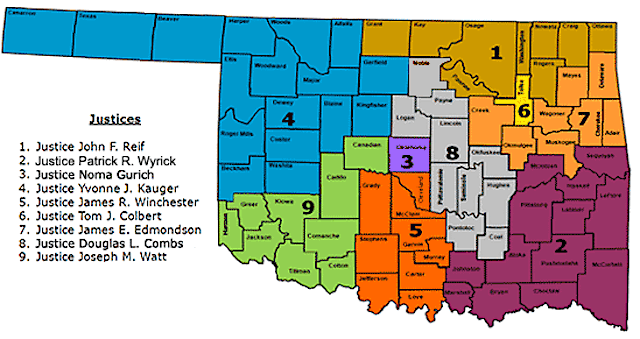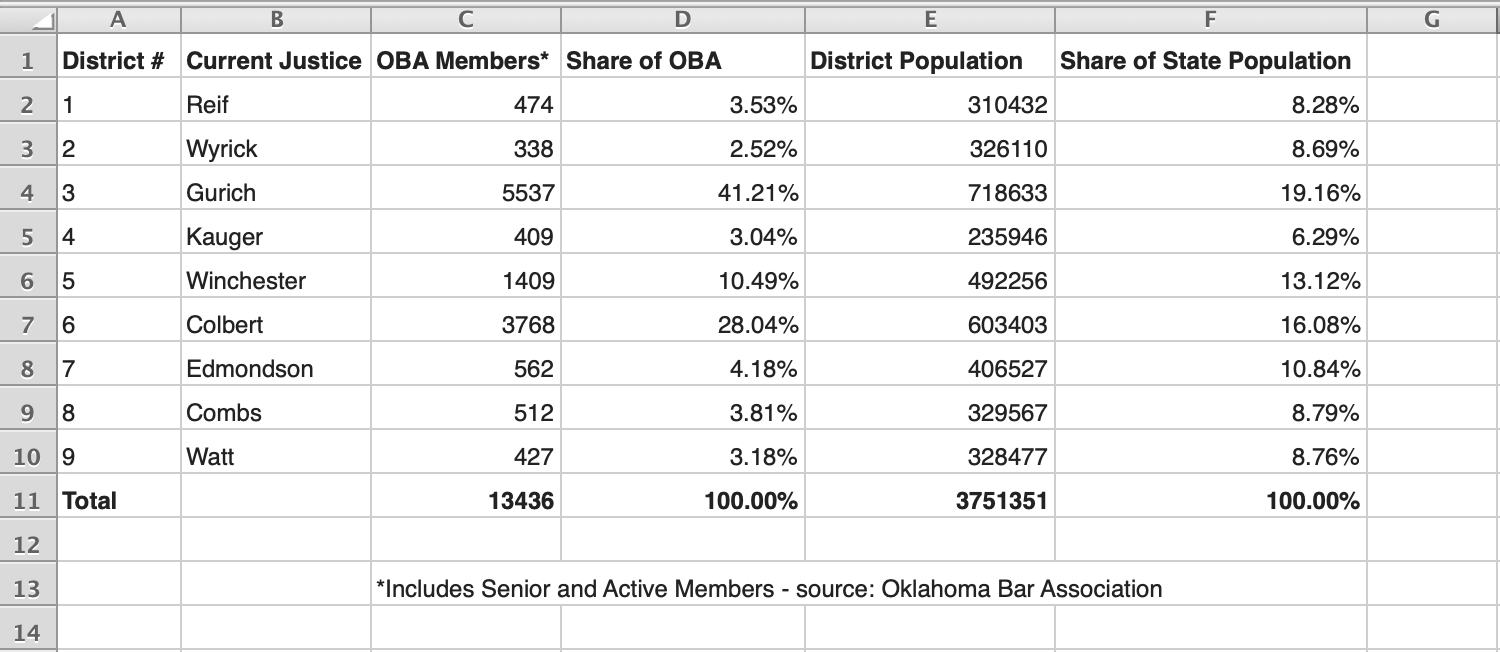
A lot has changed since the Oklahoma Supreme Court district map shown above was drawn in 1967, especially the state’s demographics.
As such, both of the Legislature’s judicial committee chairpersons believe regional requirements for the nine-member Supreme Court should be updated after reviewing data about where Oklahoma attorneys reside.
“There are about 13,000 members of the Oklahoma Bar Association, and you have a significant percentage of those living in Oklahoma City and Tulsa,” said Sen. Julie Daniels (R-Bartlesville) when discussing her SB 973. “[My bill] is intended to enlarge the pool of candidates.”
Like Rep. Chris Kannady’s HB 2366, Daniels’ bill would eliminate the 1967 map featuring nine geographic districts and stipulate that one justice be selected from each of Oklahoma’s five congressional districts. The remaining four justices would be selected “at-large” from applicants anywhere in the state.
The changes would affect the selection of new Supreme Court justices after Jan. 8, 2020, and Daniels’ version would reflect congressional district boundary updates on an ongoing basis. Both bills would also align the Oklahoma Court of Criminal Appeals with Oklahoma congressional districts.
“The purpose of the bill is to ensure that we realign [the court districts], modernize the way we select these judges, but also that we get the best and brightest applicants to serve on our courts,” said Kannady (R-OKC). “We know the population of the state has shifted in many different ways.”
Background: How Supreme Court justices are chosen
In Oklahoma, Supreme Court justices and other jurists are appointed by the governor after he or she receives a list of three names from the Judicial Nominating Commission, a 15-member panel established in the Oklahoma Constitution in 1967.
Spurred by a 1965 scandal over Supreme Court justices accepting bribes, the JNC now accepts judicial applications, vets candidates and provides the governor with choices for appointment.
The 1967 state question established the nine Supreme Court Districts but included clarification in Article 7 Section 2 that “each district shall remain as presently constituted until otherwise provided by Statute.”
Bulk of Oklahoma attorneys reside in urban centers
The State Chamber of Oklahoma is working with a coalition of attorneys and business leaders who support the proposed legislation. The coalition compared Oklahoma Bar Association membership information with population demographics, and the State Chamber provided the analysis to NonDoc.
The data highlight disparities in attorney numbers across the current nine Supreme Court districts:

“We support the concept of judicial redistricting,” State Chamber President and CEO Fred Morgan said. “We think it is time to make some adjustments to that system and create a larger pool to select from for each individual district.”
Each of the state’s two most-populous counties currently feature their own Supreme Court districts. As such, Oklahoma County (5,537 OBA members) and Tulsa County (3,768 OBA members) combine to hold more than 69 percent of the state’s total OBA members.
“At one time, all of the population in all of the judicial districts was roughly equal,” Morgan said. “Because of population changes, there is a significant difference between the population in, say, the central Oklahoma region than the northwest region.”
The current fourth district of the Supreme Court, held by 81-year-old Justice Yvonne Kauger, covers northwestern Oklahoma and features only 409 OBA members.
Represented by 37-year-old Justice Patrick Wyrick, the court’s second district covers much of southeastern Oklahoma and features only 338 OBA members.
Wyrick was one of only four attorneys who even applied for the high-profile judicial appointment in 2016, and his eligibility to represent the district as an Atoka native was challenged by the ACLU. The resultant court hearing underscored complexity in the “qualified elector” requirement added into the Oklahoma Constitution in 1967.
“That is a real-life example of the problems that are perpetuated by the district boundaries as they are currently drawn and the need to have (…) open districts,” Daniels said. “The Wyrick example is a very good one.”
Kannady also discussed Wyrick, who owns a home in south Oklahoma City and, ironically, is his constituent, according to county and state records.
“Currently, Justice Wyrick has been nominated for the federal bench,” Kannady said. “If he goes, there are only about 350 eligible lawyers in that district, whereas there are about 5,500 in Oklahoma City alone.”
Bipartisan concern from rural #okleg members
Kannady’s bill could be heard this week in Tuesday’s House Judiciary Committee meeting, but at least one committee member from rural Oklahoma would likely voice concerns.
“If we end up with a bunch of urban attorneys who don’t understand rural Oklahoma, which is the potential, then I think the Supreme Court would not reflect the people of the state of Oklahoma who actually have cases before them,” Rep. David Perryman (D-Chickasha) said. “So that has been my objection.”
Across the Capitol, a fellow southwestern Oklahoma attorney has similar hesitations about changing the current districts.
“The concern for me and what I want to kind of ensure is that all of Oklahoma has a voice in that third branch of the government,” said Sen. Brent Howard (R-Altus). “It is a touchy issue, being from rural Oklahoma and looking at the way the districts would be re-written.”
Howard and Perryman both expressed concern that a bench full of urban jurists could leave the Supreme Court without much personal knowledge about issues prominent in rural Oklahoma.
“Trial lawyers in rural areas, I think, really dig into the cases. Because when jury trials come through, there’s not much else on their docket,” said Howard, who practices in Altus and OKC. “In Altus, it has been my experience that you really get a lot more questions from the judges because they have delved into the case and looked at each issue as opposed to having 60 things coming up on one docket at one time.”
Kannady, however, said he believes broadening the pool of potential Supreme Court applicants is important.
“I’m not concerned that rural Oklahoma is going to be shut out because this bill still covers all of Oklahoma,” Kannady said. “It gives all lawyers the ability to apply.”
John Williams, executive director of the Oklahoma Bar Association, said his organization has no comment on the bills.
(Editor’s note: The State Chamber of Oklahoma has purchased advertising on NonDoc in 2019.)





















